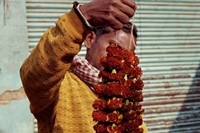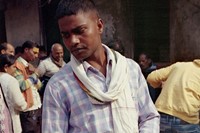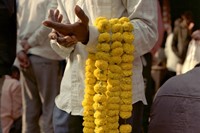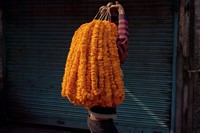Inspired by the significance of flowers in Indian culture and cremation rituals, Billy Barraclough’s latest photo project hones in on the beauty of an ancient flower market in Varanasi
In India, flowers are not merely found in vases or wrapped in brown paper. They spill from the market onto moments of daily life, where jasmines are used as hair accessories, handmade garlands are exchanged at wedding ceremonies, and marigolds in orange and yellow hues are offered to deities in prayer. In periods of mourning, these flowers, ‘the food of the spirit’, take on a sacred quality. When the photographer Billy Barraclough visited the river banks of the Ganges, where hundreds of bodies are covered in flowers and cremated every day, it was this very quality of the fragrant blossom that drew him in.
“There was an immeasurable sense of beauty and care in how each family dressed their departed loved ones in beautiful, bright garlands in preparation for the cremation rituals,” he tells AnOther of the time he spent at the ghats in Varanasi. “Traditions and emotions around death are hidden away and almost secretive in English culture, so seeing how visible and public these rituals are in Varanasi had a seismic effect on me and pushed me to reconsider my own relationship to death.” Barraclough wanted to capture these emotions but recognised that the ghats, where the ceremonies were performed, were much too intimate a setting for a camera. Instead, he shifted his attention to one of Varanasi’s oldest flower markets.
In Flowers To Dress The Dead, Barraclough’s watchful gaze moves around the flower market, capturing moments of quietness and spectacle. Images of farmers holding up multiple floral garlands opposite shuttered storefronts are interspersed with tightly packed shots of the market in motion. With staggering clarity, Barraclough describes the first couple of days he spent watching the market from various vantage points, noting how flower sellers would arrive, jot down their wares and begin their days. “Even just the way the flower sellers would enter the market was just brilliant. They would stroll in with these huge parcels of flowers, placed on their heads or on the back of their bikes, that would be dropped onto the floor and beautifully untied. Almost instantly, people would swarm over to the sellers, and the bartering would begin.”
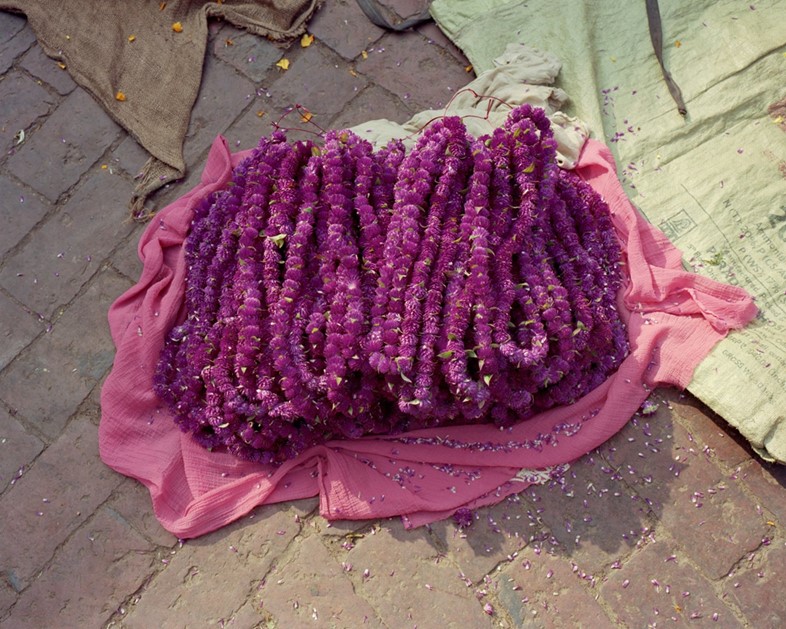
“As soon as I entered the tiny courtyard, it engulfed me,” he continues, referencing the theatrical quality of the space. “There was a ritualistic flow that underscored how the people at the market moved and used their bodies, especially their hands. The farmers would handle the flowers beautifully when they held them up for inspection and wrap them in paper parcels once sold.” Wanting to convey the sense of delicateness of the market, Barraclough’s photographs capture the ways farmers hold their bodies and interact with their physical spaces. The images are as much a homage to the farmers as they are to the flowers in front of them.
“When someone passes, the flowers that are used to dress them have this huge symbolic weight, and I wanted to convey that sense of importance and care through these photographs, Barraclough shares. “While I wasn’t thinking too deeply about the specific frames I gravitated towards while shooting, looking through these images now, I see how people’s hands offered a real ability to foreground this sense of care, touch and intimacy.” This sentiment is particularly poignant in the images where the subject’s body is outside the frame, and instead, arms holding yellow and orange marigolds and their delicate shadows make up the shot.

“When you’re in a place like Varanasi and go to the market, it is easy to become immersed in the spectacle of the flowers and perhaps overlook their significance,” he explains. “But when you witness the cremations at the Ghats, where bodies are handled with such care and reverence, wrapped impeccably and transported from distant places, you realise the depth of the process and the crucial role flowers play in this, adding to the beauty of how the bodies are treated. Through this series, I wanted to capture this modality of the flowers and its intimate ties with mourning.”

